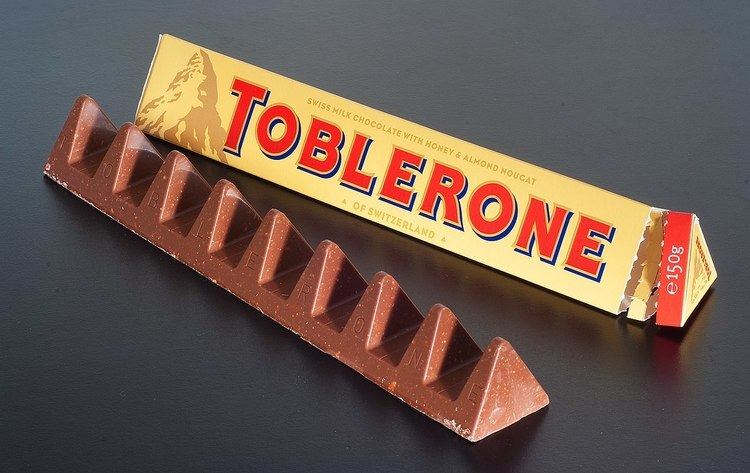Product type Confectionery | Country Switzerland | |
 | ||
Owner Mondelēz International (U.S.) Introduced 1908; 109 years ago (1908) Previous owners Kraft General Food (-2012), Jacobs Suchard AG (-1990), Interfood S.A. (-1982), Tobler (-1970) Website | ||
Toblerone (/ˈtoʊbləroʊn/; German: [tobləˈroːnə]) is a Swiss chocolate bar brand owned by US confectionery company Mondelēz International, Inc., formerly Kraft Foods, which acquired the product from former owner Jacobs Suchard in 1990. It is produced in Bern and in early 2000 was being produced in the United States by Ferrara Pan candy company in Bellwood, Illinois. Toblerone is well known for its distinctive triangular prism shape.
Contents
History
Toblerone was created by Theodor Tobler (1876–1941) in Bern, Switzerland, in 1908. Theodor Tobler, with his cousin Emil Baumann, developed a unique milk chocolate including nougat, almonds and honey with a distinctive triangular shape. The image of a bear is hidden in the Matterhorn high mountain, symbolizing the town of the chocolate's origin.
The triangular shape of the Matterhorn in the Swiss Alps is commonly believed to have given Theodor Tobler his inspiration for the shape of Toblerone. However, according to Theodor's sons, the triangular shape originates from a pyramid shape that dancers at the Folies Bergères created as the finale of a show that Theodor saw.
Some early advertisements for Tobler chocolate appeared in the international languages Esperanto and Ido.
Theodor Tobler applied for a patent for the Toblerone manufacturing process in Bern in 1909. The Toblerone brand was trademarked in 1909, at the Swiss Federal Institute of Intellectual Property in Bern.
The Tobler company was independent for many years. In 1970, it merged with Suchard, the makers of Milka, to become Interfood. The Tobler company merged with the Jacobs coffee company in 1982 to create Jacobs Suchard. Mondelēz (Kraft Foods Inc.at that time) acquired the majority of Jacobs Suchard, including Toblerone, in 1990.
Name
The product's name is a portmanteau combining Tobler's name with the Italian word torrone (a type of nougat).
Sizes and variants
Bar sizes range from ten centimetres to nearly one metre, all similarly proportioned. According to Schott's Food & Drink Miscellany the sizes and number of peaks for Toblerones are as follows:
For the yearly Toblerone Schoggifest, a special oversized bar is created to celebrate the bar's anniversary. The bar's weight represents the years of Toblerone, with the first bar in 2008 weighing 100 kg.
In 1932 Tobler made the first filled bars of chocolate, the Tobler-O-rum.
Since the 1970s, other variants of Toblerone have been produced. These include:
2016 size changes
In 2016, a larger gap was introduced between each section of the triangular prism, in two of the bars in the United Kingdom. This was done in order to cut the weight of the bars and reduce costs, while retaining the same package size. This change reduced the weight of what had been the 400g (now 360g) and 170g (now 150g) bars, other sizes of bar were unaffected. The change was not well received, with one MSP calling for 'government action' by the Scottish Parliament over the change.
Manufacturing
It has in the past been manufactured in other locations including Bedford in England. In the 1970s and 1980s, it was manufactured under license for the Yugoslav market by Kraš in Zagreb (present-day Croatia).
Similar products
A similar product is the Croatian product Kolumbo, made by factory Kraš from Zagreb. This chocolate is also composed of pyramids of hazelnuts and honey. Kraš was producing Toblerone under license during the 1970s and 1980s. Another comparable product is Mahony, produced by the company Chocolat-Frey AG in Switzerland.
Cultural impact
It has been suggested that the distinct pyramidal shape of the bar lent its name to the Toblerone line, a series of anti-tank emplacements prevalent in Switzerland's border areas. However, the Toblerone brand was trademarked in 1909, at the Swiss Federal Institute of Intellectual Property in Bern.
In 1995 it was revealed that the Swedish politician Mona Sahlin had bought, among other things, two bars of Toblerone using her Riksdag credit card (i.e., with taxpayers' money). This became known as the Toblerone affair. Sahlin was forced to step down as a candidate for the post as Prime Minister. She returned to politics in 1998.
A triangular shaped set of student residences on the Oxford Road, Manchester, for students of the University of Manchester built circa 1975 and resembling the chocolate bar are known as the Toblerones.
In theatre production, a three-sided, free-standing, wheeled version of the standard theatre flat is commonly called a "Toblerone" or "Tobe" due to its physical resemblance to the confection.
From 1973 until its demolition in 2013, there was an iron ore silo in Almería, Spain, nicknamed "Toblerone" due to its similarities with the shape of this chocolate bar.
